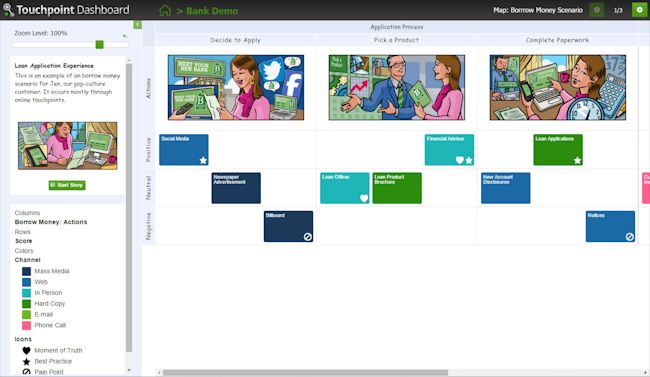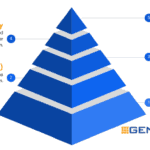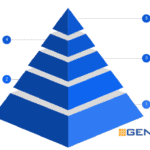With the rise and rise of interest in Customer Journey Mapping there has been a commensurate rise in software tools to document, manage and print the resulting maps.
In this post I review a wide range of software based customer journey mapping tools that can be used by organisations and their B2B marketing agencies to document the maps they create and make a suggestion on which to select for your needs.
I am not going to review the many marketing automation systems (HubSpot, Marketo, etc) that provide a way to view the sales journey. This post is focused on User Experience (UX) and Customer Experience (CX) journey mapping tools.

Dedicated Customer Journey Mapping Tools Vs Diagramming and Process Documentation Tools
There are two main classes of software tools you can use for documenting your customer journey.
Dedicated customer journey mapping tools like Smaply or SuiteCX and genelaised diagramming and process documentation tools like Miro or Visio.
There are pros and cons to each selection:
Pros of Dedicated Customer Journey Mapping Software
- Specialised functionality: Customer journey mapping tools are designed specifically for mapping and analysing the customer experience, and offer features like persona creation, touchpoint mapping, and analytics that are tailored to this task.
- Integration with other tools: Some customer journey mapping tools integrate with other platforms, such as Slack, Trello, and Google Drive, making it easier to incorporate customer journey data into other aspects of users’ workflow.
Cons of Dedicated Customer Journey Mapping Software
- Cost: Dedicated customer journey mapping tools can be expensive, which may be a barrier for smaller businesses or teams on a tight budget.
- Learning curve: Learning to use a new tool can take time and may require additional training or support.
- Limited functionality: While dedicated customer journey mapping tools offer specialised functionality, they may not be as versatile as diagramming and process documentation tools for other tasks.
Pros of Diagramming and Process Documentation Tools
- Versatility: Tools like Miro and Visio are designed to be more versatile, allowing users to create a wide range of diagrams and process documentation beyond just customer journey maps.
- Familiarity: Users who are already familiar with these tools may find it easier to create customer journey maps using a tool they are already comfortable with.
- Cost: Diagramming and process documentation tools may be more cost-effective than dedicated customer journey mapping tools.
Cons of Diagramming and Process Documentation Tools
- Limited customer journey mapping features: While these tools may be versatile, they may not offer the same level of specialised functionality for creating customer journey maps as dedicated tools do.
- Integration: Integration with other platforms may be limited or not available at all in some diagramming and process documentation tools.
Ultimately, the choice between a dedicated customer journey mapping tool and a diagramming and process documentation tool depends on the specific needs of the user or business.
Dedicated tools may offer specialised functionality and collaboration features that are ideal for creating and analysing customer journey maps, while diagramming and process documentation tools may be more versatile and cost-effective for users who need to create a wide range of diagrams and documentation beyond just customer journey maps.
Dedicated Customer Journey Mapping Tool Options
Out of Dark
Out of Dark is a new customer journey mapping tool designed to make it easy for businesses to visualise, track and optimise their customer experience.
The tool includes features for mapping out customer touchpoints and interactions, creating detailed customer personas, setting goals and KPIs, assigning ownership of tasks, and driving improvements. It aims to bring together journey mapping, analytics dashboards, and task management into one user-friendly platform.
Based on the current feature set, Out of Dark looks like a promising customer journey mapping option for small to midsize organisations looking for an affordable all-in-one solution. However, as a newcomer it remains to be seen how the platform will develop and fare against more established competitors over time.
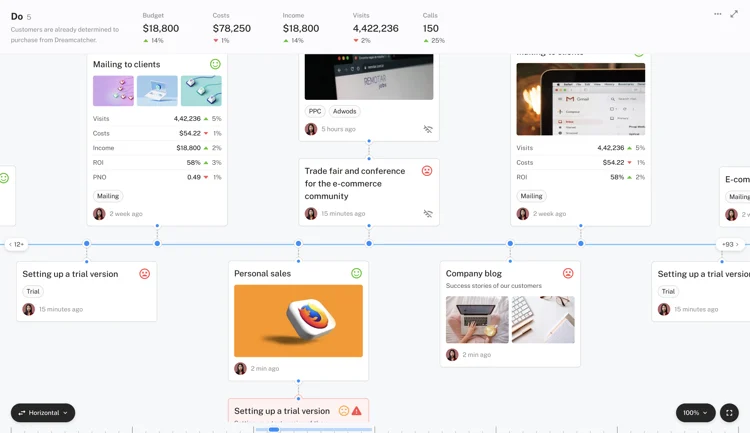
Price
Out of Dark uses simple pricing of $USD29/month which includes all features. They also offer a 14-day free trial.
This is, however, an EARLY ACCESS price. There is no indication of where the price might fall longer term
For now this puts the tool in the low to mid-price range for customer journey mapping software. The all-in-one pricing is straightforward compared to other tools with tiered plans.
Pros
- Intuitive interface: Out of Dark emphasises ease of use, allowing customer journeys to be mapped out quickly without requiring special expertise. The drag-and-drop journey builder makes it simple to visualise touchpoints.
- Brings together multiple CX tools: The platform integrates journey mapping with persona development, KPI tracking, task management and more. This could streamline processes for CX teams.
- Affordable pricing: At $29/month with no usage limits, it is an economical option compared to enterprise-focused platforms. The pricing is transparent with no hidden fees.
- Actionable improvements: Beyond just mapping, Out of Dark includes features for assigning ownership, setting goals, and tracking progress on experience improvements. This helps teams move from insight to action.
Cons
- Newer product: As a brand new entrant to the market, Out of Dark doesn’t yet have an established track record or many customer reviews available. Some organisations may prefer a more time-tested solution.
- Limited integrations: The initial feature set focuses on core journey mapping and task management functionality. It doesn’t appear to include pre-built integrations with other marketing, analytics or CX platforms at this stage.
- No Reviews: At the time of writing (March 2024) there were not validated reviews available for this software.
Quadient: Inspire Journey
Quadient are an integrated mail processing (hardware and software), parcel locker and customer communication solution business. The customer communication part of the business includes a SaaS journey mapping application called Inspire Journey.

Price
Quadient do not publish prices and do not offer a free trial.
It can be assumed that this puts them in the higher-price bracket for journey mapping tools.
Pros
- Advanced data integration: with Microsoft PowerBI and REST APIs, allowing real-time data to be embedded into journey maps.
- Project prioritization capabilities: based on customer impact.
- Includes Journey Map and Personas
- Connect maps: The ability to connect multiple maps to each other along with a global map
- Leading platform, according to tech analysts: Forrester and Quadrant both show this platform in their respective “leadership” categories.
Cons
- Large Company: is a multi-faceted global firm with a presence in approximately 30 countries and over 3,500 employees. The division in which Inspire Journey Mapping is housed is around Euro180m. Medium and smaller customers can find it difficult to get focus in such an organisation.
- Few Reviews: There are very few validated reviews available for this software.
- Steep learning curve: Some users have noted that Quadient: Inspire Journey can have a steep learning curve, making it difficult for new users to get started with the tool.
CX Omni
Founded in 2014, CX Omni is a SaaS based customer journey mapping platform that incorporates journey analytics. It appears to be targeted at larger businesses and enterprise customers.
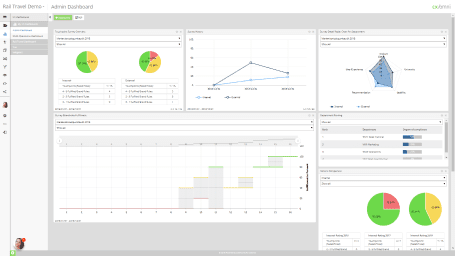
Price
Prices are not public on the site but Capterra reports pricing starts at USD990 per month.
This puts the system in the high-price bracket for journey mapping tools.
Pros
- Data Integration: Data from a wide variety of sources (web analytics, marketing automation, CRM distribution, etc) can be pulled into the system via API.
- Multiple Views : including Heatmaps, Difficulty Impact Matrix, Swimlane, Storyboards and Emotional Journey.
- Action tracking: action and goal tracking is included in the system.
Cons
- Small Company: this is a relatively small (~16 people) company based in Germany. There is the potential for large clients to overwhelm their ability to deliver. It is also not clear how they delivery to locations around the world.
- Few Reviews: As a smaller company there are relatively few reviews of the software.
Clarivate Customer Experience (CX) Services (formerly CustomersFirst Now)
CustomersFirst Now was founded in December 2014 when the company acquired Mulberry Consulting. In early 2021 Clarivate purchased CustomersFirst Now and it currently trades as Clarivate Customer Experience Services.
The new business combines Journey Mapping software and services with the software rebranded to CFN Insight
Clarivate Customer Experience is a customer journey mapping tool that allows businesses to visualise and analyse the end-to-end customer experience, identify gaps and opportunities for improvement, and ultimately improve customer satisfaction and loyalty. The tool integrates with other Clarivate products, such as Web of Science and Derwent Innovation, to provide a more comprehensive view of the customer experience.
The system was launched in July 2016 and does not look to have been comprehensively re-engineered since the acquisition.

Price
Prices are not public on the site but when added to this list prior to the acquisition prices started at USD500 per month for a 2 Author/20 Map system and go up to USD1,500 per month for an unlimited author/unlimited map system.
This puts the system in the mid-price bracket for journey mapping tools.
Pros
- Easy to use: the interface is intuitive and easy to use with modern features such as drag and drop. This reduces the learning curve for implementation.
- Multi-access: “Authors” are able to make changes to maps and publish them in real time. Unlimited “viewing” access gives everyone in the organisation the ability to see the maps.
- Nice filter and views: there are some nice filtering and reporting features that allow you to quickly view the maps through different lenses: customer pain points, Moment of Truth, Business Owner, etc.
- Action tracking: there is some simple action and goal tracking included in the system.
- Exports: you can export data to a variety of formats including PDF.
- Flexible maps: the maps layouts and element attributes are flexible and easily configured.
Cons
- No live operational data: No way to import data live from other business systems to populate the map. For instance, if you want to track transactional NPS for a touchpoint it has to be manually entered. I’m told this is on the development roadmap.
- Limited dashboard view: The current dashboard focuses on the statistics of the journey maps — number of maps, number of touchpoints. Unfortunately it does not yet report on the status of all touchpoints easily or comprehensively. So you can’t quickly view touchpoint attributes and performance against goals. I’m told this is on the development roadmap.
- No map view: No process map view of the data; it is limited to a rows and columns format.
- Limited customisation: While it offers a range of features for creating customer journey maps, some users have found that the tool can be limiting in terms of how much customisation is possible beyond these features. “It could be more flexible in terms of customisation.” (Source: TrustRadius)
smaply
Smaply is a customer journey mapping tool developed by More than Metrics, a user research and design company based in Austria and founded by co-authors of This is Service Design Thinking.
Smaply allows users to create and visualise customer journey maps, personas, and stakeholder maps to gain insights into the end-to-end customer experience.
The tool also offers collaboration features, integrations with other platforms, and customisable templates to help users streamline their workflow and create more effective customer journey maps.
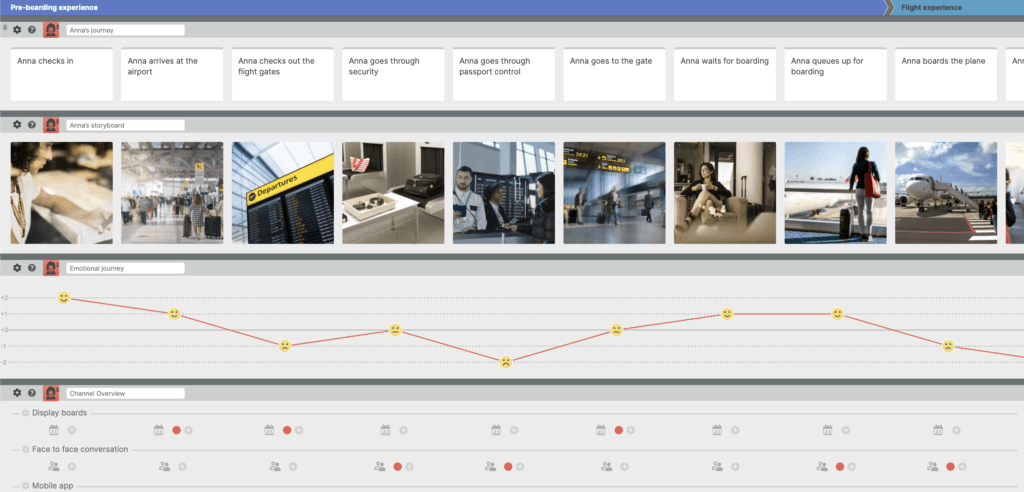
Price
- Free Plan
- Paid plans start at 19 Euro per person per month
Pros
- Comprehensive mapping features: Smaply offers a range of mapping features that allow users to create detailed customer journey maps, including touchpoint maps, personas, and stakeholder maps. “It has a good range of features and customisation options.” (Source: G2)
- Customisable template: Different detail levels allow the customisation of journey maps by adding storyboards, channels, emotional journeys, dramatic arcs, storyboards, backstage processes and much more. Templates can be duplicated and re-used. Personas and stakeholder maps can be customised with a drag and drop editor.
- Learning resources included: Video tutorials and guides for journey maps, personas and stakeholder maps help lead you through the design process.
- Export options: There is the ability to export the maps to high-resolution PDF files for printing on posters and other large format printers. Exports are also available in PowerPoint, PNG and Excel formats.
- Feedback mode and sharing: users can collaborate directly in-app (various user access levels are available), or have read-only access to an HTML version. Others can be invited to give feedback via the integrated comment mode.
- Scaling through journey map hierarchies: journey maps can be linked together to connect projects, illustrate hierarchies, re-use findings and keep the overview on large numbers of journeys.
- Sharing: Users can collaborate with team members to work on customer journey maps together in real-time, making it easier to share ideas and insights and ensure everyone is on the same page.
- Integrations: integrates with a range of other tools and platforms, including Slack, Trello, and Google Drive, making it easier to incorporate customer journey data into other aspects of users’ workflow. Allows the upload of files to journey maps so they can be used as an insights hub. Lastly, an API is available for enterprise customers.
Cons
- Limited customisation: While Smaply offers a range of templates that users can customise, some users have found that the tool can be limiting in terms of how much customisation is possible beyond these templates.
- Limited reporting: Some users have noted that Smaply’s reporting features are limited compared to other customer journey mapping tools, which can make it more difficult to analyse data and identify areas for improvement.
- Fixed format: all of the programmed mapping tools suffer from this issue of not being 100% free format – mind you this is also a pro in that you have fewer choices so you can focus on the mapping task rather than formatting and layout options.
- End of agreement data access: As with any SaaS tool set you need to consider what will happen to intellectual property you have developed if you decide to cease using the tool. Can it be easily transferred to other systems? In this case data is downloadable as PDF, PNG, PowerPoint and Excel.
UXPRESSIA
UXPRESSIA looks to be developed by a small team and is an easy to use tool.
It allows you to create customer journey maps, personas, and impact maps. Using a simple two-dimensional grid (much like Excel) users can add rows sections (User Goals, Process, Experience, etc) and columns (stages in the process) to the map. It offers other features, such as real-time online collaboration for multiple users, live integration with prototyping and analytics tools, custom branded export, user management, and presentation mode.
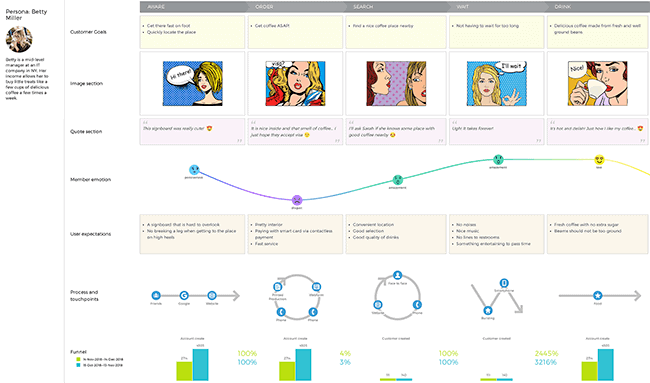
Price
- Free Plan
- Paid plans start at USD24 per person per month
Pros
- User-friendly interface: Many users have found the UXPRESSIA tool to be easy to use, with an intuitive interface that makes it easy to navigate and create customer journey maps.
- Project Organisation: for companies running multiple journeys this tool will manage your persona sets with your maps. This also means you can copy entire projects and share them with the team.
- Solid Persona tool: a flexible and functional persona tool provides the ability to add custom fields, change the look of the personas, with lots of details that can be added to your persona definition.
- Journey Mapping help: Lots of on-line help about the customer journey mapping process itself.
- PDF Export: Export to PNG or PDF for large scale printing.
- Integrations: UXPRESSIA integrates with a range of other tools and platforms, including Slack, Trello, and Google Drive, making it easier to incorporate customer journey data into other aspects of their workflow.
Cons
- Row and Column presentation: While this is easy to use and the sections are flexible it does not provide a journey view
- No operational data on the map: There is no ability to load operational data on touch-point performance.
- Limited customisation: While UXPRESSIA offers a range of features for creating customer journey maps, some users have found that the tool can be limiting in terms of how much customisation is possible beyond these features.
- Technical issues: Some users have reported experiencing technical issues with the tool, such as slow loading times or glitches in the interface. “The platform can be a bit slow at times.” (Source: SoftwareAdvice)
suitecx
According to the developers:
suitecx® allows users to make fact based decisions and process improvements that are grounded in the customer experience. Customer-centric diagnostics, touch inventories, experience maps, data-driven personae and customer storytelling and precision marketing are all components of this groundbreaking software.
This tool is an integrated CX mapping tool with substantial functionality. It also comes in two versions: a comprehensive tool (suitecx) and a “buy by the unit” tool called Primer Products.
It also includes some marketing roadmap features.
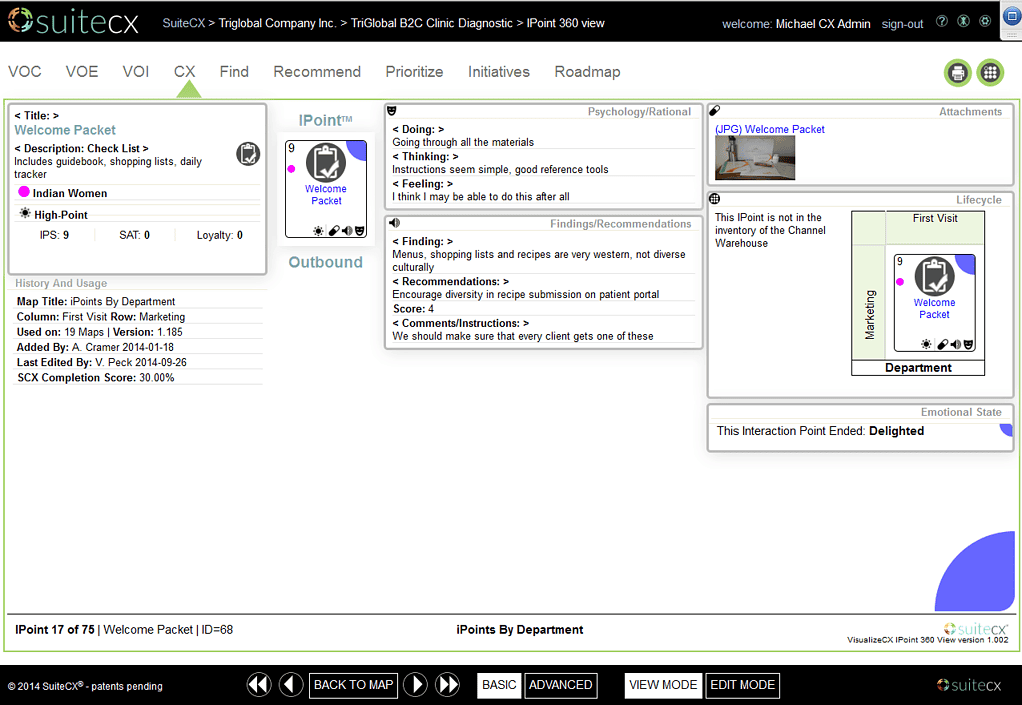
Price
Pricing for the suitecx product USD15,000 p.a. per module (visualizecx, diagnosticcx, precisioncx) for 3 users. Each unit of the Primer Products is USD50 per month per user.
Pros
- Integrated application: The tool allows you to create and link a range of data sources within the same tool.
- Comprehensive: Certainly this tool appears to provide a very comprehensive range of functions and views of the data – story maps, process flows, grid view, virtual sticky notes, roll-up views, survey data integration, prioritisation, road-maps, contact strategy, campaign planning
- Easy sharing: Sharing is browser based so it should be simple and easy to access in many places.
Cons
- Still in development: While the full tool envisages a substantial range of features, several of them appear to not yet be launched (collaboratecx, processcx, campaigncx) As with any sophisticated software tool you will need a change management process to set this up properly in your business.
- Price: Some users have found SuiteCX to be expensive compared to other customer journey mapping tools on the market, which may be a barrier for smaller businesses or teams on a tight budget. “The price point could be a limiting factor for some businesses.” (Source: TrustRadius).
- Just released: with the first releases of the product being in last 2014 this software is early in the development cycle so care needs to be taken.
Diagramming and Process Documentation Software That Can Be Used for Customer Journey Mapping
MURAL
MURAL pitches itself as a collaboration platform first and foremost. It’s main product is an on-line canvas that can be used for a variety of different graphical data including: process maps, brain storming, diagramming, planning and more.
One of the those applications is Customer Journey Mapping.
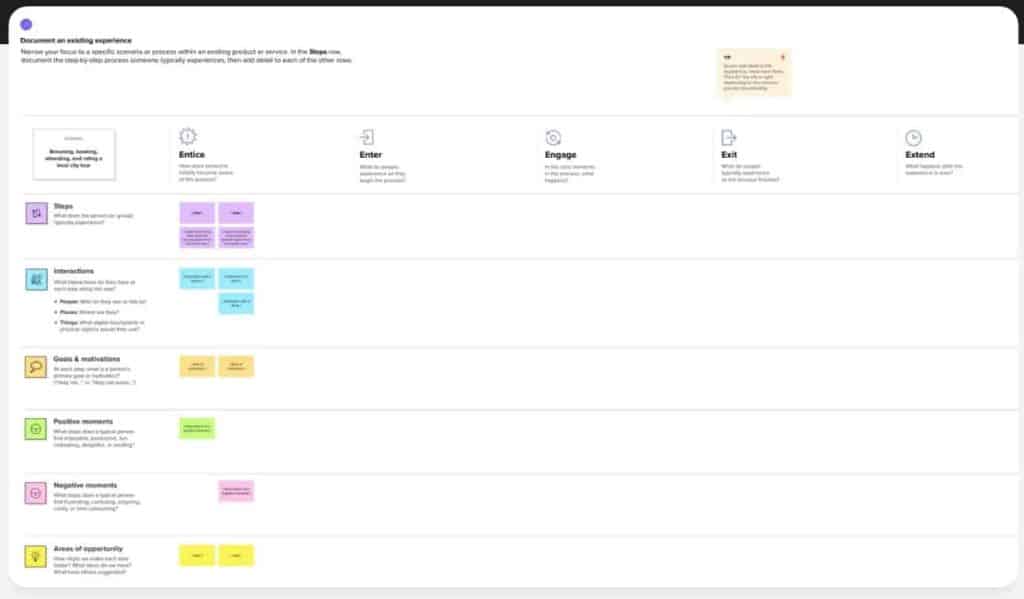
Price
- Free tier with 3 editable “murals”
- Paid subscriptions start at USD9.99 per user per month and go up to Enterprise levels.
Pros
- Large Company: MURAL is the largest of the businesses on this list. With more than 800 employees it has the scale to quickly bring new features to market.
- Very flexible: Multiple approaches (mind map, journey map, schedules, etc) can all be added to the same worksurface so you can integrate planning and execution elements on the same worksurface. This also means you can use the one tool for various tasks within the organisation.
- Good collaboration features: As it was built from the ground up for collaboration this feature works well, including the ability to share password protected versions outside the organisation.
- Live Data Integration: using a combination of direct integrations and Zapier, it is possible to automatically push and pull data from MURAL boards.
Cons
- Very flexible: If you don’t plan your document layout and hierarchy well, you can end up with a single confusing mass of diagrams on the same worksurface. This is because the size of the worksurface is, essentially, infinite and you can just keep adding to it.
- Hard to print large format: Given the scale of maps that can be generated it can be difficult to push them to paper, if you need it.
Miro
Miro is a multi-faceted platform that allows users to collaborate in real time with a variety of graphical business tools, e.g. mind map, process diagrams and journey maps.
It’s basically a virtual whiteboard where staff can build shared visual and planning documents.
It is, in many ways a competitor to Mural, see above.
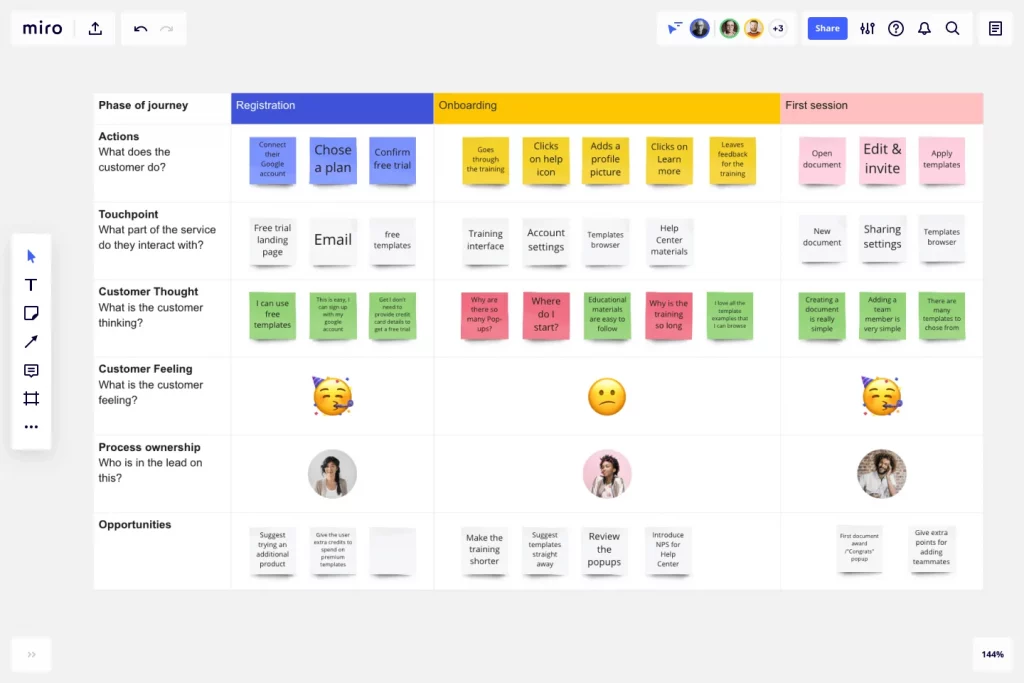
Price
- Free tier with 3 editable board
- Paid subscriptions start at USD8 per user per month
Pros
- Very flexible: Multiple approaches (mind map, journey map, schedules, etc) can all be added to the same worksurface so you can integrate planning and execution elements on the same worksurface. This also means you can use the one tool for various tasks within the organisation.
- Good collaboration features: As it was built from the ground up for collaboration this feature works well, including the ability to share password protected versions outside the organisation.
- Document portability: It is relatively easy to export/import data to/from the software so you’re not stuck in the one platform.
- Live Data Integration: using a combination of direct integrations and Zapier, it is possible to automatically push and pull data from Miro boards.
Cons
- Not built for mapping: However, given the flexible nature of the tool and large number of pre-built templates to choose from, this is not a substantial issue.
- Very flexible: If you don’t plan your document layout and hierarchy well, you can end up with a single confusing mass of diagrams on the same worksurface. This is because the size of the worksurface is, essentially, infinite and you can just keep adding to it.
- Hard to print large format: Given the scale of maps that can be generated it can be difficult to push them to paper, if you need it.
Microsoft PowerPoint

Yes it’s a bit old school but PowerPoint can be a very effective tool for documenting customer journey maps.
Price
Included for most businesses that use the MS Office suite of products.
Pros
- Familiar tool: This is a very common tool for business users, so the learning curve is basically non-existent.
- No additional cost: If you have the MS Office suite of products then you probably already have it so there is no additional software to purchase
- Very flexible: The flexibility of shapes, layouts and linking elements is very large and they are easy to format in terms of colours and sizes.
- Limited collaboration features: In later versions of PowerPoint users can work on a presentation/map at the same time.
- Document portability: It is relatively easy to export/import data to/from the software so you’re not stuck in the one platform.
Cons
- Not built for mapping: PowerPoint is not really designed as a process or mapping tool and so many of the tasks you will perform often, e.g. linking shapes, don’t have short cuts.
- Too flexible: The extreme flexibility means that different people will format maps in different ways and this can detract from the consistent view you might want. Also the flexibility means staff may spend too much time on getting formats consistent.
- Hard to print large format: Getting page sizes correct can be difficult and there is no easy way to create large scale (think several feet or metres across) documents formatted and printed.
Microsoft Visio

This is a general purpose process mapping and software design tool developed by Microsoft. It’s been around for many years and is quite mature.
Price
Approximately: AUD450 or USD300
Pros
- Low training requirement: Visio is like PowerPoint but with a process design straight-jacket. The interface is very familiar and relatively easy to learn.
- Process design focused: Because it is a process design tool many repetitive tasks, like joining shapes, have default actions so it’s quick and easy to document your map.
- Standard symbols: It has a range of standard symbols and forms from which you can select. Many have built in behaviours that make it easy to create maps.
- Limited flexibility: While there are many formatting options, the straight-jacket limits the infinite freedom of PowerPoint and it is quicker and easier for users to get to a finished document that looks good and is consistent with others.
- Easy document printing: Visio is designed to print large documents easily and will, by default, let you create any sized map you like. Then when you go to print your map Visio simply splits it up into a jigsaw of printed pages that you can join to create your map in large scale.
- Document portability: It is relatively easy to export/import data to/from the software so you’re not stuck in the one platform.
Cons
- Added cost: As a specialist piece of software you will probably not have a copy on everyone’s desktop. While it’s not especially expensive when you start rolling it out to multiple desktops the price can mount up.
- Static maps: Visio was never designed for multi user sharing and editing of documents so documents can become centred on just one person, reducing the ability to share the map across the organisation.
- Difficult collaboration: Visio stores maps as files and while you can share the files, merging changes from different users is not automated.
Canvanizer
Canvanizer is a general purpose business documenting tool that started out focusing on the Business Model Canvas.
The Business Model Canvas was made famous by Alexander Osterwalder and Yves Pigneur in their book Business Model Generation: A Handbook for Visionaries, Game Changers, and Challengers
Canvanizer also has a range of other documents it can produce, including Customer Experience Canvases and Service Design Canvases.
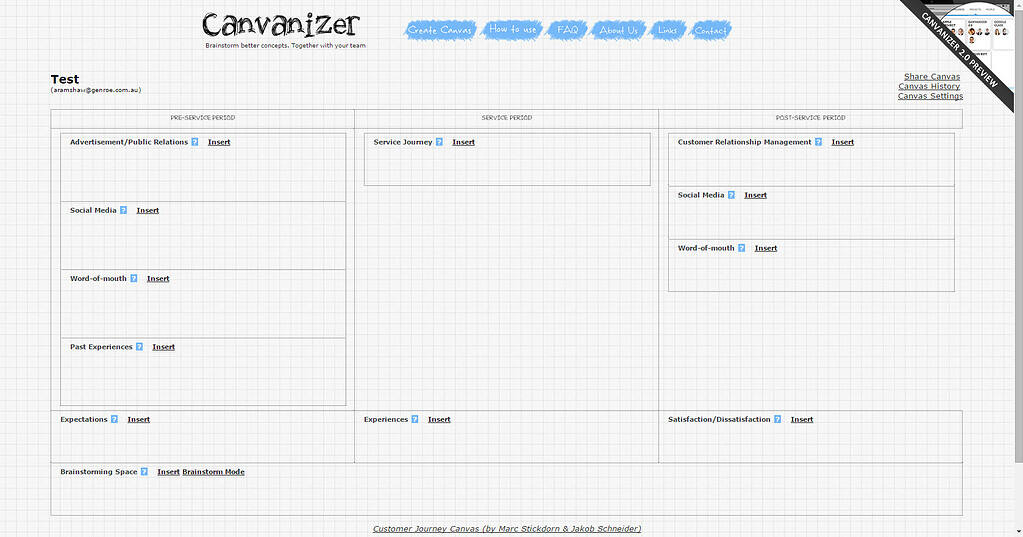
Price
Free, at the moment.
Pros
- Price: as far as I can tell this is a free service
- Simple: setting up a new canvas is easy (1 click) and it’s quite easy to use.
- Easy to use: Adding elements and moving them around is drag and drop
- Sharing is easy: you can share editable and read only links to the canvas
Cons
- Fixed format: the format of the canvas is fixed with specific areas and terms. If you don’t like the way the map is laid out there is nothing you can do to change it.
- Printing is not great: while it’s easy to share the map electronically, printing it out to post on the wall relies on your browser’s printing functions and so is quite limited.
- Text only: each of the elements is fixed format and text only so you can’t add pictures or diagrams to the map.
Visual Paradigm
Visual Paradigm has its roots in software design and data models.
In many ways software requirements collection and design processes are very similar to customer journey mapping. Both require features such as user (customer) requirements collection, process flow design, task management, etc.
So while this tool has been designed for software development it can be used very effectively for customer journey mapping. Plus it is currently sitting at version 12 so the software has a long history and a deep functionality set.
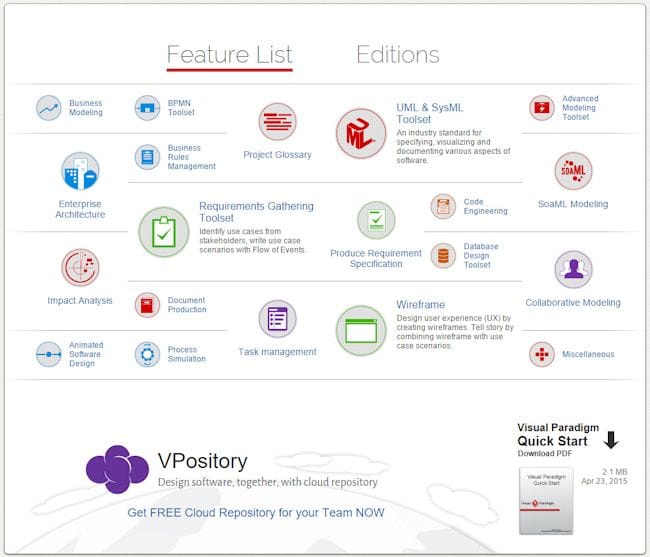
Price
Starting at USD5 per month per user but the USD35 per month version would be needed for customer journey mapping.
Pros
- Collaborative modelling: in the software industry is it common for several software developers to write code on the same program in parallel. This sounds like a recipe for disaster but the industry has developed processes to allow this to happen safely. Visual Paradigm has these processes built deeply into the product. The benefit for customer journey mapping is that it allows several people to work on the process independently and then merge their ideas quickly and effectively.
- Deep functionality in service and process design: The process and service designer elements of the system are very flexible. For instance the Business Modelling feature includes a built in RACI responsibility matrix
- Integrated task management: Tasks that arise from the process can be handed off to a task management module with project management abilities.
Cons
- Steep learning curve: this is a sophisticated product focused on the software development industry. It is flexible enough to be used in customer journey mapping but it will take time to develop an effective approach and train staff in its use. The features are very relevant but many of the terms used for those features will be unfamiliar to non-software developers in the organisation.
- Cost: the costs for the service are not high but they are ongoing and per user based.
The Right Customer Journey Mapping Tool For You
Of course, there is no one right solution for all organisations.
I’m inclined to steer away from software developed by consulting organisations. While they have a good understanding of what is needed, software development is a specialist skill. And as their “first love” is consulting it will always pull management focus and resources away from software development.
Best Customer Journey Mapping Tool for Enterprises
If you are a large organisation, with many staff, all working together on customer journey mapping then these tools offer the level of features you will probably be looking for:
- CXOmni
- SuiteCX
They are large scale with very full feature sets that allow you to not only map your customer journey but manage the process of improving it.
However, these tools require a substantial investment in process design so they are expensive both in term of software fees and organisational time to implement.
Best Customer Journey Mapping Tool for Small and Mid Sized Businesses
For small to mid-tier organisations you will not need the power of the Enterprise solutions and will want to maximise your value from your software investment.
The two on-line canvas options (Miro and MURAL) provide good, and extensible, solutions with bonus of being able to use them for a range of other tasks, e.g. meeting management, braining storming, service mapping, etc.
So, the best customer journey mapping tools for small and mid-sized businesses are:
- Miro
- MURAL
- Out of Dark – while new, this product looks promising
They have few restraints and you will be able to build the map that works best for your needs. You can quite quickly build some real maps, experiment with what works for your organisation and gain experience.

Last Updated: 28 March 2024
